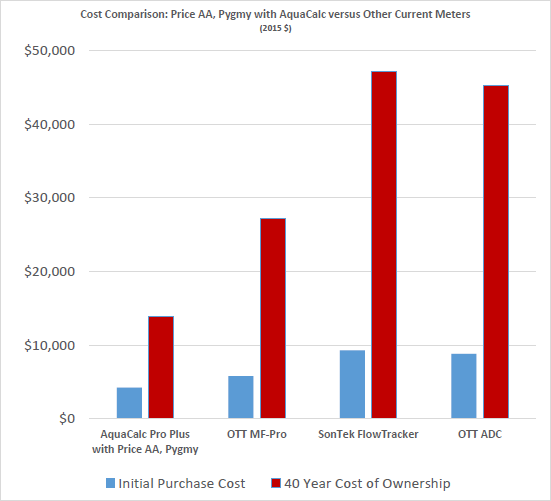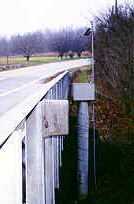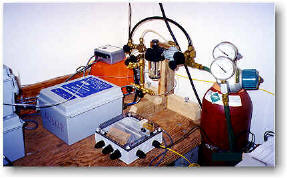 Loading... Please wait...
Loading... Please wait...Hydrological Equipment
NEWS RELEASE
Cost and Accuracy Comparisons

Mechanical Current Meter System with AquaCalc Versus Other Point Velocity Discharge Systems
Download PDF
Stage Measurement
 The stage of a stream or lake is the height of the water surface above an established datum plane. The water-surface elevation referred to some arbitrary or predetermined gage datum is called the gage height. Gage height is often used interchangeably with the more general term stage, although gage height is more appropriate when used with a reading on a gage. Stage or gage height is usually expressed in feet and hundredths of a foot.
The stage of a stream or lake is the height of the water surface above an established datum plane. The water-surface elevation referred to some arbitrary or predetermined gage datum is called the gage height. Gage height is often used interchangeably with the more general term stage, although gage height is more appropriate when used with a reading on a gage. Stage or gage height is usually expressed in feet and hundredths of a foot.
In stream gaging, gage heights are used as independent variable in stage-discharge relation to derive discharges. Reliability of the discharge record is therefore dependent on the reliability of the gage-height record as well as the stage-discharge relation. Several different types of stage measuring devices are available from the simple to the most sophisticated technology with automatic digital data recording.
Gage-height records may be obtained by a water-stage recorder, by systematic observation of a water-stage recorder, by systematic observation of a non-recording gage, or by noting only peak stages with a crest stage gage. For U.S. Geological Survey primary records at gaging stations, two basic types of water level sensors are used: the float in a stilling well, or by a gas purge (bubble gage) system which transmits the pressure head of water in the stream to a manometer or pressure transducer. The primary instrument used by the USGS since the 1950's for stage measurement has been the STACOM manometer with a bubbler pressure system. However, due to the environmental and personal safety hazards with the mercury used with this manometer, these are no longer used and have been replaced by several different instrument options which are described in this section.
 Recorders for these sensor elements can be graphic, such as the Type F and A-71, or digital data loggers such as the Aqualog series or other commercially available loggers. Systems can be set up to also record both graphically and digitally. Non-recording gages generally used are staff, wire-weight, float-tape and electric tape.
Recorders for these sensor elements can be graphic, such as the Type F and A-71, or digital data loggers such as the Aqualog series or other commercially available loggers. Systems can be set up to also record both graphically and digitally. Non-recording gages generally used are staff, wire-weight, float-tape and electric tape.
Non-recording gages are still in general use as auxiliary gages at water-stage recorder installations to serve the following purposes:
As a reference gage to indicate the water-surface elevation in the stream.
As a reference gage to indicate the water-surface elevation in the stilling well. Gage readings on the stream are compared with the reference readings in the well to determine whether stream stage is being obtained in the well.
As a temporary substitute for the recorder when the intakes are plugged or there is equipment failure. The outside reference gage can be read as needed by a local observer to continue the record of stage during the malfunction.
Staff and wire weight gages are normally used at non-recording gaging stations. They are also used as the outside reference gage at recording gaging stations. Float- and electric-tape gages and the vertical staff gage are used in stilling wells. Staff gages are read directly whereas the other three types are read by measurement to the water surface from a fixed point.
